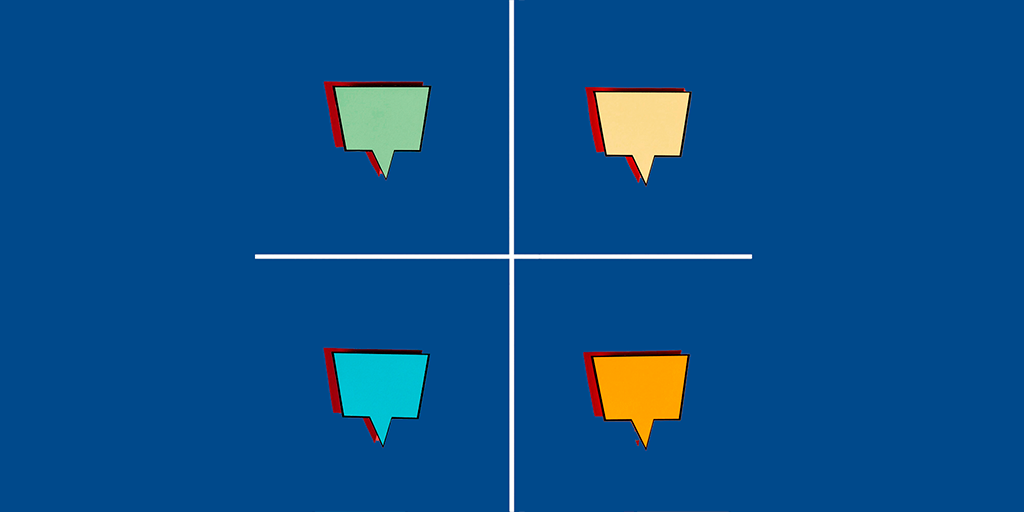
–English Pronunciation Thought Group Rules | Image by The Alphabet
“Last summer my family and I took a road trip across the country We started in California where we visited several national parks and then we drove through the deserts of Arizona and New Mexico Along the way we stopped at many small towns met some interesting people and tried local foods that we had never experienced before By the time we reached the East Coast we had seen so many amazing places and created memories that will last a lifetime”
设想一下,如果上面的一个没有标点的段落是我们日常阅读的对象,我们的阅读体验会发生怎样的变化?在阅读过程中,标点符号通常被认为是理所当然的存在,它们为我们提供了结构和指引,使信息的传达变得更加流畅。然而,当标点符号消失时,阅读体验会发生显著的变化。从认知行为的角度来看,标点符号在阅读中的作用至关重要。人类的认知系统依赖于清晰的结构和线索来处理信息,而标点符号正是提供这些结构的关键元素。
当标点符号缺失时,读者的认知过程会受到显著影响,导致认知负荷的增加。在没有标点符号的情况下,读者必须主动分辨句子中的逻辑和语法结构,依赖更多的短期记忆和推理能力来理解文本,这会导致大脑的认知资源被过度消耗。标点符号为信息的分段处理提供了自然的界限,缺乏这些界限,读者的信息处理速度会减慢,使得阅读过程更加缓慢且不连贯。因此,我们需要对该段落加上合适的标点符号,以帮助我们更好地理解段落信息。如下为分割后的阅读段落结构:
Last summer, my family and I took a road trip across the country. Started in California, where visited several national parks, and then drove through the deserts of Arizona and New Mexico. Along the way, stopped at many small towns, met some interesting people, and tried local foods that had never experienced before. By the time reached the East Coast, had seen so many amazing places and created memories that will last a lifetime.
上述断句和分割后的段落使阅读更清晰易懂。通过将长句分成较短的片段,信息变得更容易理解,减少了读者的认知负担。同时,分段提供了自然的停顿点,使阅读更流畅,增强了逻辑性,帮助读者更好地把握内容之间的关系。这种清晰的结构提升了阅读效率和愉悦感,使信息传达更加准确。
在信息处理的过程中,作为读者和听众,我们在阅读和听力中的“断句”模式有着本质的区别。阅读时,读者可以依赖标点符号来明确句子的结构,标点符号提供了清晰的视觉线索,帮助读者分辨句子之间的界限,理解信息的逻辑关系。这种方式使读者能够以自己的节奏来处理和消化内容,甚至可以回读某些部分来强化理解。
然而,在听力场景中,听众面临的情况则要复杂得多。听众没有视觉上的标点符号来指引他们的理解,信息的接收是实时的,无法回头重新审视。因此,听众必须依赖于说话者的语调、停顿和节奏来“断句”,即通过这些听觉线索来划分和理解信息的结构。如果说话者未能有效地进行“断句”,或者“thought groups”之间的界限不明确,听众可能会难以跟上对话的节奏,信息处理变得更加困难。
面对这一问题,听众需要在听力中依靠“thought group”这一概念。听众可以将语音中的每个“thought group”视为一个基本的理解单位,这类似于在阅读中以标点符号为依据来理解句子的方式。通过注意说话者的自然停顿和语调变化,听众能够更好地抓住每个信息片段的核心含义,从而构建出整个句子的完整理解。这样,即使在没有视觉线索的情况下,听众也能有效地“断句”,提高对口语内容的理解力。
因此,虽然阅读和听力在“断句”模式上有所不同,但通过掌握和运用“thought group”的概念,听众可以有效应对听力中的“断句”挑战,使信息的理解更加流畅和精准。
在听力中,合理地划分“thought groups”是提升理解力的关键。具体来说,常见的“thought group”单位包括名词短语(Noun Phrases)、主语(Subjects)、动词短语(Verb Phrases)、介词短语(Prepositional Phrases)和从句(Clauses)。这些基本单位帮助我们在听力中自然地分割信息,使复杂的句子变得更易理解。接下来,通过具体的例子来说明如何运用这些“thought groups”进行有效的分割和断句。
1. 名词短语(Noun Phrases)
The charming little cottage overlooks the beautiful lake.
- 断句:The charming little cottage | overlooks | the beautiful lake.
分析:在这个句子中,“The charming little cottage”和“the beautiful lake”都是名词短语。通过将它们作为独立的“thought groups”分割出来,听众可以轻松理解主语和宾语,明确句子的核心信息。
A tall glass of cold water was just what I needed.
- 断句:A tall glass of cold water | was | just what I needed.
分析:这里,“A tall glass of cold water”是名词短语,描述了需要的具体内容。通过将其作为一个单独的“thought group”,听众能够清晰识别句子的主语,进一步理解句子的含义。
2. 主语(Subjects)
The new employee, who has a lot of experience, quickly adapted to the job.
- 断句:The new employee | who has a lot of experience | quickly adapted | to the job.
分析:“The new employee”作为主语部分独立出来,迅速让听众了解句子的主角是谁。后续的“who has a lot of experience”补充了主语的背景信息,进一步丰富了句子的内容。
My neighbor’s dog, which barks loudly at night, finally calmed down.
- 断句:My neighbor’s dog | which barks loudly at night | finally calmed down.
分析:句子中的主语是“My neighbor’s dog”,通过将其作为一个“thought group”,听众能够快速抓住主语。附加的从句“which barks loudly at night”则提供了更多的描述性信息。
3. 动词短语(Verb Phrases)
The artist decided to create a mural on the city wall.
- 断句:The artist | decided | to create a mural | on the city wall.
分析:动词短语“decided to create”表达了句子的核心动作。通过将这个短语分割出来,听众可以迅速理解句子的动作部分,接着通过“on the city wall”了解动作发生的地点。
They have been working on the project for several months.
- 断句:They | have been working | on the project | for several months.
分析:动词短语“have been working”描述了正在进行的动作,将其作为一个独立的“thought group”有助于听众更容易识别和理解句子的核心内容。
4. 介词短语(Prepositional Phrases)
She left her book on the table next to the lamp.
- 断句:She left her book | on the table | next to the lamp.
分析:在这个句子中,“on the table”和“next to the lamp”是介词短语,分别提供了位置信息。将这些短语独立出来作为“thought groups”,使得听众能够清晰理解物体的具体位置。
The cat hid under the bed during the thunderstorm.
- 断句:The cat | hid | under the bed | during the thunderstorm.
分析:介词短语“under the bed”和“during the thunderstorm”明确了动作的地点和时间。将这些短语分割出来,有助于听众逐步理解句子的背景信息。
5. 从句(Clauses)
When the sun rises, the birds begin to sing.
- 断句:When the sun rises | the birds | begin to sing.
分析:句子开头的“when the sun rises”是条件从句,描述了时间背景。通过将其独立出来作为一个“thought group”,听众可以迅速理解事件发生的时间条件。
Although it was raining, we decided to go for a walk.
- 断句:Although it was raining | we | decided | to go for a walk.
分析:这个句子中的“Although it was raining”是让步从句,提供了上下文条件。将从句独立出来,使听众更容易理解句子的逻辑关系和整体意义。
6. 复合句和复杂句(Compound and Complex Sentences)
The project, which has been in development for over two years, is finally nearing completion, and the team is excited about the upcoming launch.
- 断句:The project | which has been in development for over two years | is finally nearing completion | and the team | is excited | about the upcoming launch.
分析:这是一个复杂的复合句,包含了多个从句和并列结构。将主语“The project”独立出来,使听众迅速识别句子的主角。附加的从句“which has been in development for over two years”提供了背景信息,紧接的“is finally nearing completion”描述了主句的状态。并列句“and the team is excited”则被分为两个独立的“thought groups”,确保听众能分辨两个主要动作。
He finished his work early, so he decided to take the afternoon off and go for a hike in the mountains.
- 断句:He finished his work early | so he decided | to take the afternoon off | and go for a hike | in the mountains.
分析:这是一个复合句,句子通过连词“so”将两个动作连接起来。将主句“He finished his work early”独立出来,有助于听众理解动作发生的时间背景。之后的“so he decided”引出了后续的动作,“to take the afternoon off and go for a hike”是句子的核心动作,分割这些部分能够帮助听众逐步建立完整的理解。
当我们将这些基本的“thought group”要素——名词短语、主语、动词短语、介词短语和从句——综合应用在一个段落中时,可以有效提升听力理解。我们可以借助文章最开始提到的段落,来综合说明如何通过这些“thought groups”来进行有效的分割和断句,从而使信息更清晰、更易于处理。
Last summer, | my family and I | took a road trip | across the country. | We started in California, | where we visited several national parks, | and then we drove | through the deserts of Arizona and New Mexico. | Along the way, | we stopped at many small towns, | met some interesting people, | and tried local foods | that we had never experienced before. | By the time we reached the East Coast, | we had seen so many amazing places | and created memories | that will last a lifetime.
通过对“thought group”的深入理解和应用,我们能够在听力场景中更有效地分割和处理信息,使复杂的句子变得更加清晰易懂。无论是面对快速的对话、复杂的演讲,还是语言学习中的挑战,合理的“断句”都能帮助我们更好地跟随说话者的思路。将这些基本的“thought group”要素综合运用到日常的听力练习中,不仅可以提升我们的理解力,还能增强我们在实际交流中的自信心与表达力。通过不断实践,我们将能够在听力中更加自如地应对各种场景,从而实现更高效的沟通与理解。


